Promenade
des Anglais
Promenade des Anglais ("Walk of the English") is a celebrated promenade along
the Mediterranean at Nice, France. Before Nice was urbanized, the coast at Nice
was just bordered by a deserted band of beach covered by large pebbles. The first
houses were located on higher ground well away from the sea.
Starting
in the second half of the 18th century, the English took to spending the winter
in Nice, enjoying the panorama along the coast. When a particularly harsh winter
up north brought an influx of beggars to Nice, some of the rich Englishmen proposed
a useful project for them: the construction of walkway (chemin de promenade)
along the sea.
The
city of Nice, intrigued by the prospect of a pleasant promenade, greatly increased
the scope of the work. The Promenade was first called the Camin dei Anglais
(the English Way) by the Nicois in their native dialect Nissart. After the annexation
of Nice by France in 1860 it was rechristened La Promenade des Anglais,
replacing the former Nissart name with its French translation.
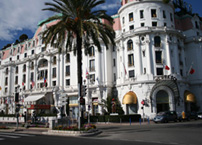
| | 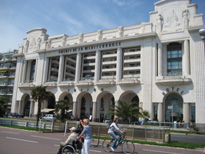 |
Hotel
Negresco and The Palais de la Mediterranée can both be seen from the Promendade |
The
Hotel Negresco on the Promenade des Anglais on the Baie des Anges in Nice, France
was named for Henri Negresco (1868-1920) who had the palatial hotel constructed
in 1912. In keeping with the conventions of the times, when the Negresco first
opened in 1913 its front opened on the side opposite the Mediterranean.
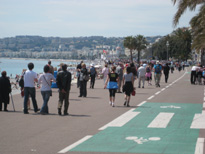 | | 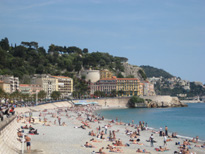 |
A
sunny day in late April on the Promenade des Anglais and the beach below |
PORT
OF NICE
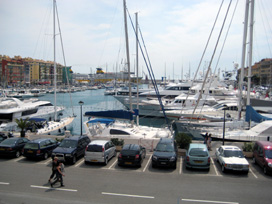 | | View
of the port of Nice |
The
port of Nice is also known as Lympia port. This name comes from the Lympia source
which fed a small lake in a marshy zone where in 1745 work of the port was started.
It constitutes today the principal harbour installation of Nice - there is also
a small port in the Carras district. The port of Nice is the first port cement
manufacturer of France in connection with the treatment plants of the rollers
of the valley of Paillon.
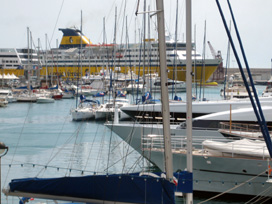 | | Ferries
frequently leave the Port of Nice to Corsica. |
Fishing
activities remain but the number of professional fishermen is now lower than 10.
Nice, being the point of continental France nearest to Corsica, has ferry connections
with the island developed with the arrival of NGV or navires at high speed. Two
companies ensure the connections: SNCM, a partially public company and Corsica
Ferries - Sardinia Ferries, an entirely private company. Located in front of the
port, the place Cassini was renamed place of Corsica.
SQUARES
Like
any Mediterranean city, the town of Nice has squares; allowing people to gather,
to organize great shows, performances or public display, or just to sit down at
a terrace.
Place
Massena
The
Place Massena is the main square of the city. Before the covering of the
Paillon River, the Pont-Neuf was the only practicable path between the old town
and the modern one. The square was thus divided into two parts (North and South)
in 1824. Since the destruction of the Massena Casino in 1979, the Place Massena
became more spacious and less dense and is now bordered by red ochre buildings
of Italian architecture.
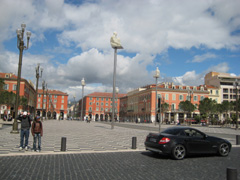 | | Place
Massena is the main square of the city. |
The
recent re-building of the tram gave the square back to the pedestrians, restoring
its status of a real Mediterranean square. It is lined with palm trees and stone
pines, instead of being the rectangular roundabout of sorts it had become over
the years. Since its construction, the Place Massena has always been the spot
for great public events. It is used for concerts, and particularly during the
summer festivals, the Corso carnavalesque (carnival parade) in February,
the military procession of July 14th (Bastille Day) or other traditional celebrations
and banquets.
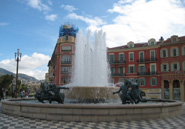 | | Fountain
a end of Place Massena |
The
Place Massena is a two-minute walk from Promenade des Anglais, old town, town
centre, and Albert I Garden (Jardin Albert Ier). It is also a large crossroads
between several of the main streets of the city: avenue Jean Medecin, avenue
Felix Faure, boulevard Jean Jaures, avenue de Verdun and rue
Gioffredo.
| View
of the Place Massena at Night | | 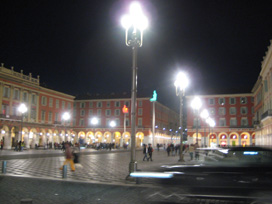 |
Place
Garibaldi
The
Place Garibaldi also stands out for its architecture and history. It is
named after Giuseppe Garibaldi, hero of the Italian unification (born in Nice,
which was still a part of Sardinia-Piedmont at the time), who was ferociously
attached to the union of Nice to Italy.
A
Statue of Garibaldi is erected in the centre of the place. The re-building of
the square (still ongoing) will make this square semi-pedestrian, making it more
pleasant.
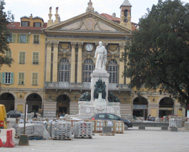 | | Statue
of Garibaldi. The place as of April 2008 was still being renovated. |
It
is a crossroads between the Vieux Nice (old town) and town centre. Place Garibaldi
is close to the eastern districts of Nice, Port Lympia (Lympia Harbor), and the
TNL commercial centre. This square is also a crossroads of important streets :
the boulevard Jean Jaurès, the avenue de la république, the rue Cassini and the
rue Catherine Ségurane.
Place Rossetti (See photo above)
Entirely
enclosed and pedestrianised, this square is located in the heart of the old town.
With typical buildings in red and yellow ochres surrounding the square, the cathédrale
Sainte-Réparateand the fountain in the centre, place Rossetti is a must-see spot
in the old town. By day, the place is invaded by the terraces of traditional restaurants
and the finest ice-cream makers. By night, the environment changes radically,
with tourists and youths flocking to the square, where music reverberates on the
walls of the small square.
The
square's lighting at night gives it a magical aspect. Place Rossetti is in the
centre of the old town, streets Jesus, Rossetti, Mascoïnat and the Pont-vieux
(old bridge)
Cours Saleya
In
the past, it belonged to the upper classes. It probably is the most traditional
square of the town, with its daily flower market. The court Saleya also
opens on the Palais des rois Sard (Palace of the Kings of Sardinia). In
the present, the court is mostly a place of entertainment. There are good
restaurants serving typical Nicois cuisine, markets and many pubs. It is no doubt
one of the most active spots in Nice.
See
also: Nice
Food Market
It
is situated parallel to the Quai des Etats-Unis.
Place
du Palais
 | | Palais
de Justice (Law Courts is located on the Place du Palais |
As
its name indicates, the place du palais is where the Palais de Justice
(Law courts) of Nice is located. On this square, there also is the Palais Rusca,
which also belongs to the justice department (home of the tribunal de grande
instance).
The
square is also notable due to the presence of the city clock. Nowadays, the Place
du Palais is alive day and night. It is particularly appreciated by youths
who hangout on the steps leading to the Palais de justice, often with alcoholic
bottles in hand. The place is not a large open-air bar, though, concerts, animations
and events are frequent.
It
is situated halfway between cour Saleya and place Massena.
CHURCHES
- Sainte-Raparate Cathedral,
17th century
- Saint-Jacques
Church, 17th century
- The
Saint Nicolas Orthodox Cathedral
- Sainte
Jeanne d'Arc Church, 20th century
- Notre-Dame
church built in 1864
- Eglise
Gesu -- 1642
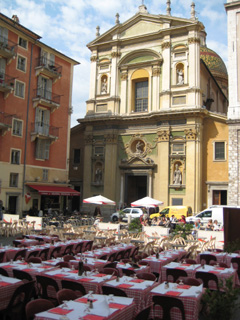 | | The
center of the Old Town (Nice Sainte-Raparate
Cathedral
17th century Located
in Place Rosetti |
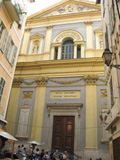 | | Eglise
Gesu located on rue Droite, is a Baroque treasure nestled peacefully in the quiet
place du Gesu. The petit Eglise du Gesu is one of the oldest parishes in Nice.
It was inspired by a Roman church but built in 1642 by a Niçois architect. |
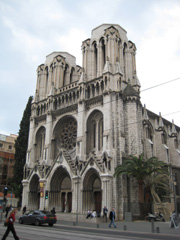 | | The
Notre-Dame church, built in 1864, is the largest church in Nice 37
bis Avenue Jean Médecin, 06000 Nice The
church only dates back to 1868 and was designed by the architect C. Lenormand |
Nice
Observatory
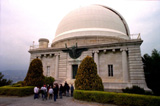 | | View
of the Bischoffsheim cupola, main cupola of Nice Observatory |
The
Observatoire de Nice (Nice Observatory) is located on the summit of Mont
Gros. The observatory was initiated in 1879 by the banker Raphael Bischoffsheim.
The architect was Charles Garnier, and Gustave Eiffel designed the main dome.
The
76-cm (30-inch) refractor telescope that became operational in 1888 was at that
time the world's largest telescope. It was outperformed one year later by the
36-inch (91-cm) refractor at the Lick Observatory.
As
a scientific institution, the Nice Observatory no longer exists. It was merged
with CERGA in 1988 to form the Observatoire de la Côte d'Azur.
The
Chateau -- "Colline du Chateau"
Just
about everyone that visits Nice climbs the steps of the "Colline du Chateau" up
to the top, which offers fabulous views over the Baie des Anges, Old Nice ,and
the Port.
On the
hilltop where the ancient castle stood, is an attractive park with wonderful green
fields, shadowy lanes and some restaurants and café's. The hilltop is situated
between two historical and attractive parts of Nice: the old town and the harbour
quarter.
You
will get some of the finest panoramic views in Europe here . It is easily accessible
from the foot of the Old town and the bay, but for those not able to make the
climb there is a lift - an "ascenseur". There
are 213 steps from the bottom to the observation platform on top of the Naval
Museum, and then more steps and various walkways on to the top.
The
Chataeu can be seen from the Promenade Anglais walking toware the port.
Culture
and Museums
Nice
is one of the oldest human settlements in the world. Terra-Amata, an archaeological
site dating to the Lower Palaeolithic age is situated near Nice. Nice was established
by the ancient Greeks. There was also an independent Roman city near Nice, where
the hill of Cimiez is located. It is an archaeological site with treasures, of
which only a small part has been excavated. The excavated site includes thermal
baths, arenas and Roman road.
Since
the second century AD, the light of the city has attracted many famous painters
such as Chagall, Matisse, Niki de Saint Phalle, Ben and Arman and inspired many
artists and intellectuals in different countries (Berlioz, Nietzsche, Rossini).
Nice
also has numerous museums of all kinds: Musée Chagall, Musée Matisse (arenas of
Cimiez where one can also see Roman ruins), Musée des Beaux-Arts Jules Chéret,
Museum of Naïve arts, Musée Terra-Amata, Museum of Asian Art, Museum of Modern
art and Contemporary art which devotes a broad place to famous “the Ecole of Nice
”), Museum of Natural History, Musée Massena, Naval Museum and Galerie des Ponchettes.
Being
a vacation resort, Nice hosts many festivals throughout the year. For example,
Carnaval de Nice and Nice Jazz Festival are among the festivals held in Nice.
Nice
has a distinct culture due to its unique history. The local language Niçard
(Nissart) is an Occitan dialect (but some Italian scholars argue that it is
a Ligurian dialect), still spoken by a huge minority. Strong Italian and (less)
Corsican influences make it more intelligible than other non-extinct Provencal
dialects.
In the
past, Nice welcomed many immigrants from Italy (who continue to make a large proportion
of the population), as well as Spanish and Portuguese immigrants. However, in
the past few decades immigration has been opened to include immigrants from all
over the world, particularly those from former Northern and Western African colonies,
as well as southeastern Asia. Traditions are still alive, especially in folk music
and dances. The most famous is farandole.
Take
a walking tour of Nice --
Gayot.com has an excellent online guide to a 3 day tour of Nice.
See
Also:
History
of Nice, France
Climate
in Nice
The
Demographics and Economy
Gastronomy
of Nice
Best
Restaurants in Nice
Best
Value Restaurants in Nice
Cours
Saleya Food Market

